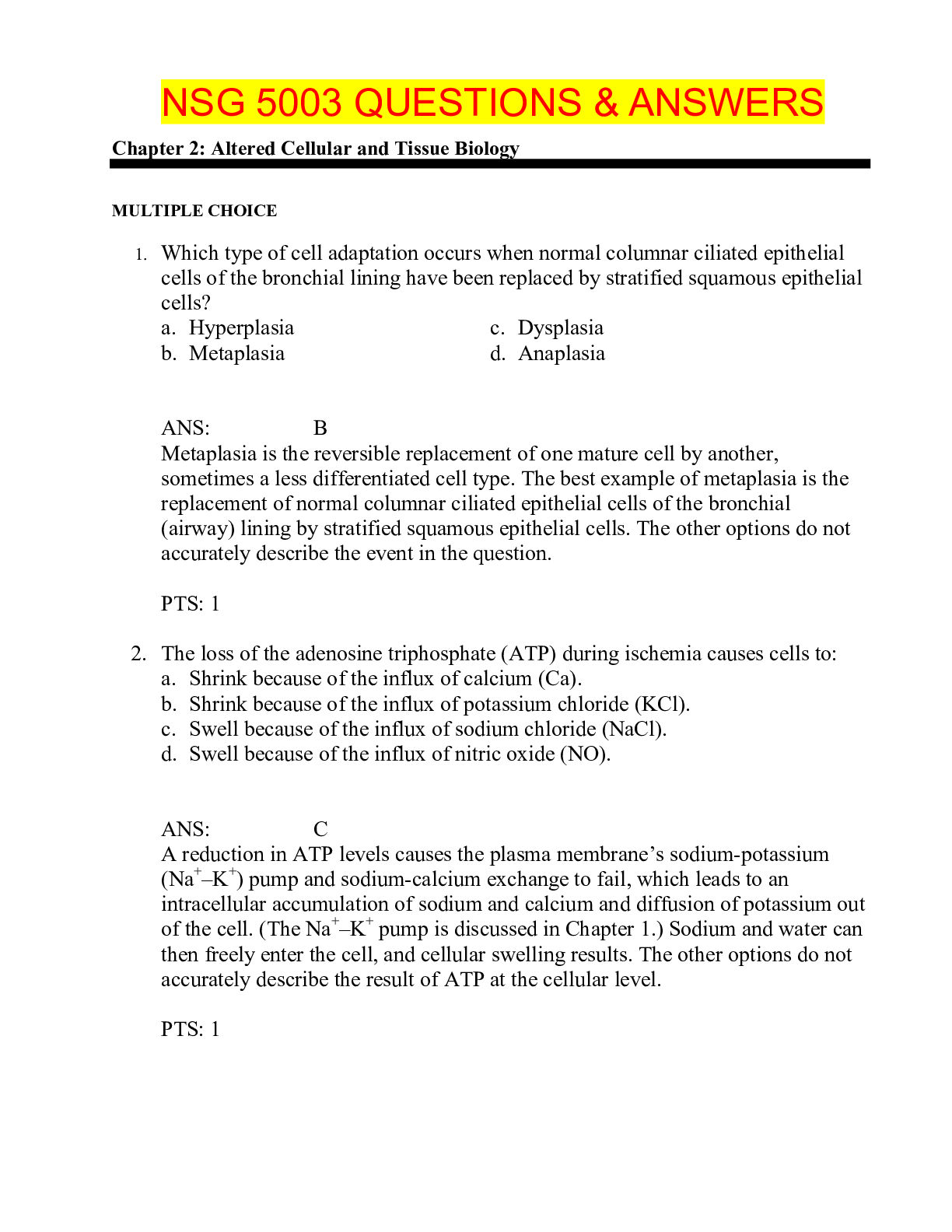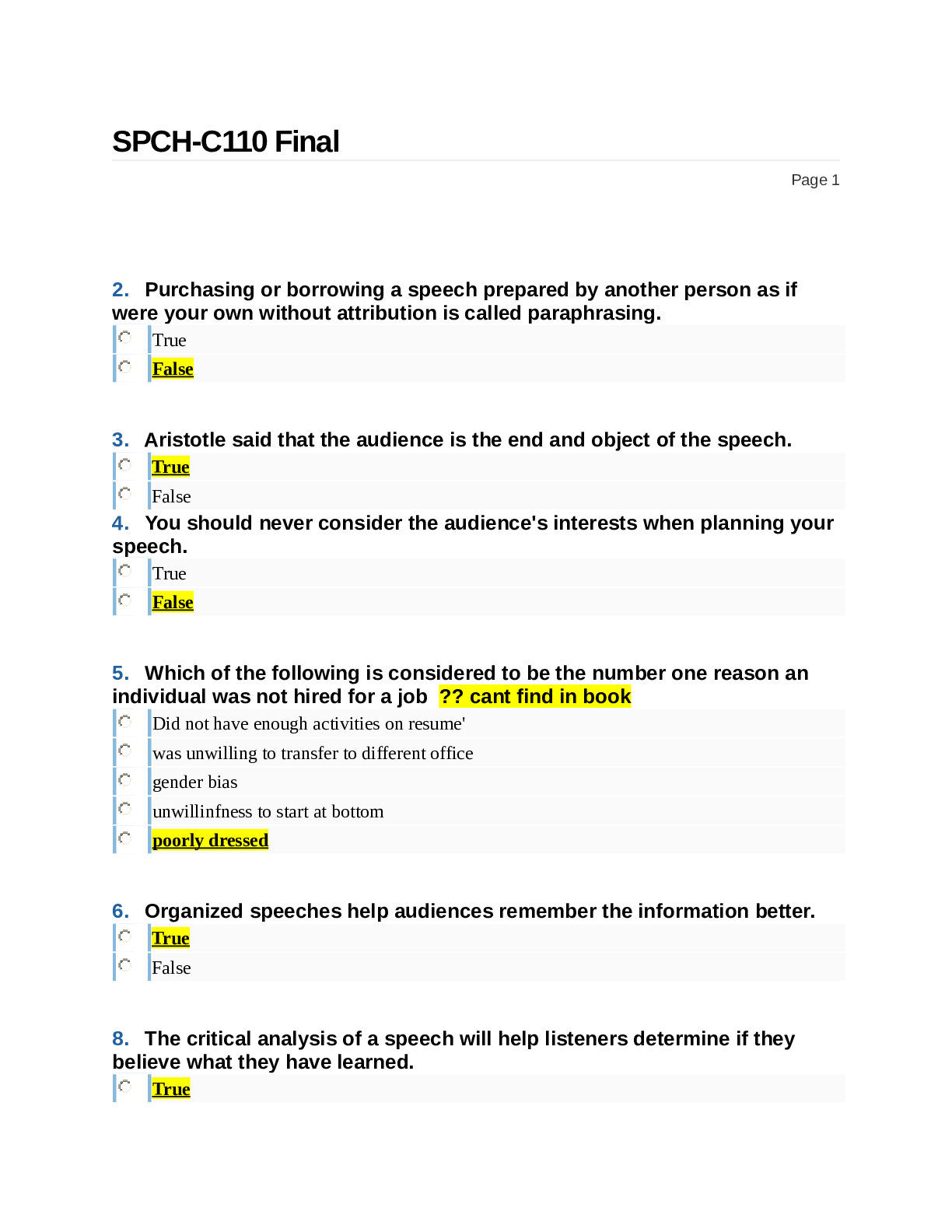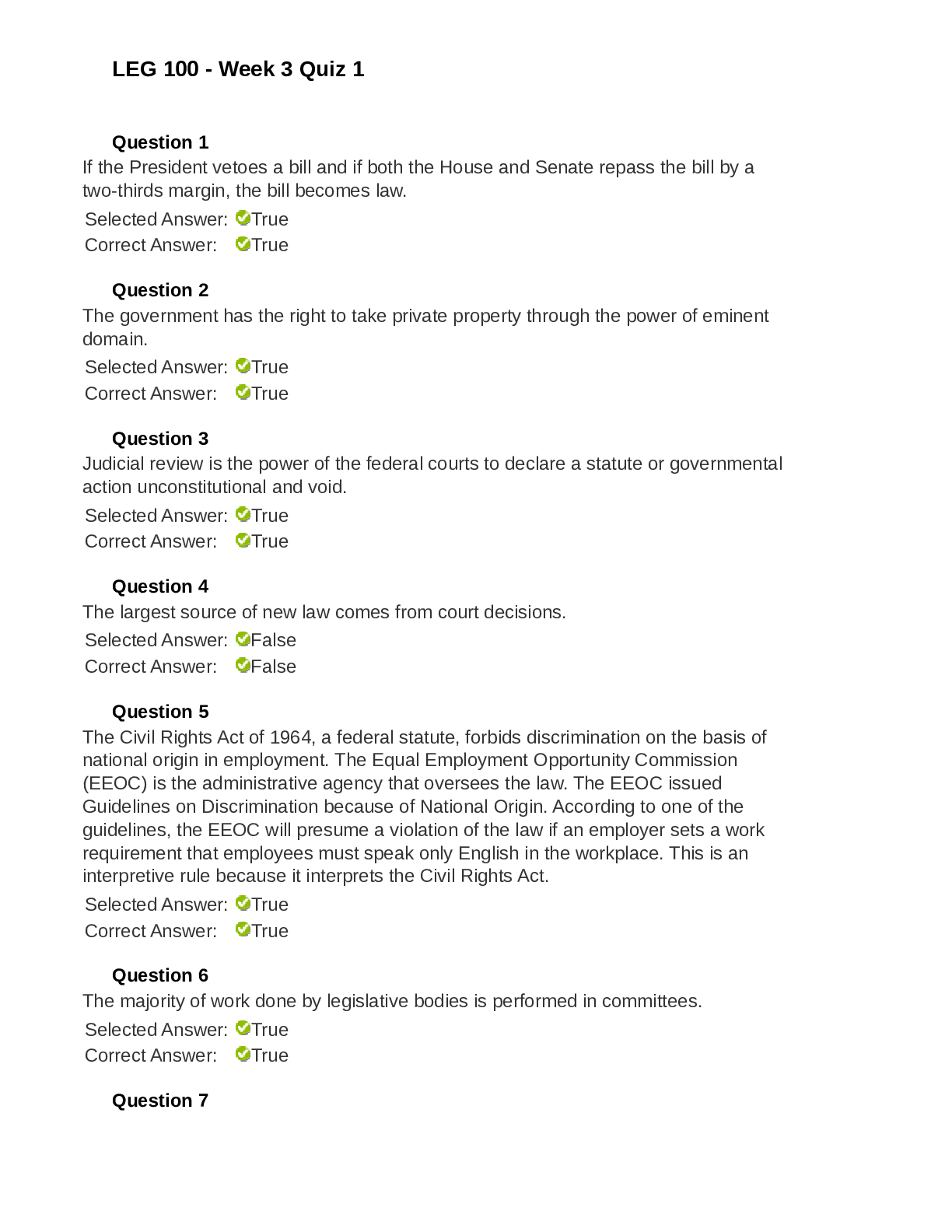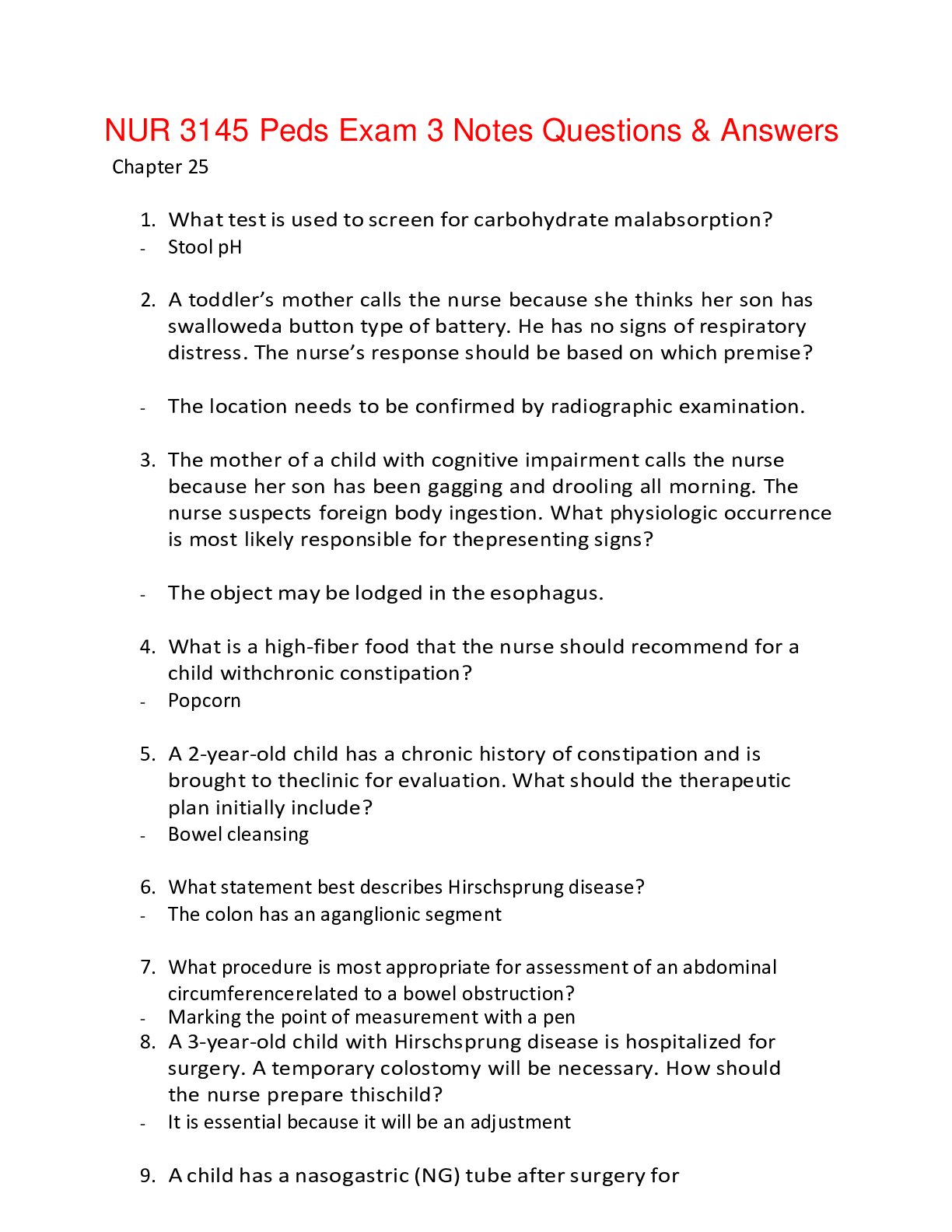NSG 5003 QUESTIONS & ANSWERS,100% CORRECT
Document Content and Description Below
Which type of cell adaptation occurs when normal columnar ciliated epithelial cells of the bronchial lining have been replaced by stratified squamous epithelial cells? a. Hyperplasia c. Dysplasia b.... Metaplasia d. Anaplasia 2. The loss of the adenosine triphosphate (ATP) during ischemia causes cells to: a. Shrink because of the influx of calcium (Ca). b. Shrink because of the influx of potassium chloride (KCl). c. Swell because of the influx of sodium chloride (NaCl). d. Swell because of the influx of nitric oxide (NO). 3. The mammary glands enlarge during pregnancy primarily as a consequence of hormonal: a. Atrophy c. Anaplasia b. Hyperplasia d. Dysplasia 4. Free radicals play a major role in the initiation and progression of which diseases? a. Cardiovascular diseases such as hypertension and ischemic heart disease b. Renal diseases such as acute tubular necrosis and glomerulonephritis c. Gastrointestinal diseases such as peptic ulcer disease and Crohn disease d. Muscular disease such as muscular dystrophy and fibromyalgia 5. Free radicals cause cell damage by: a. Stealing the cell’s oxygen to stabilize the electron, thus causing hypoxia b. Stimulating the release of lysosomal enzymes that digest the cell membranes c. Transferring one of its charged, stabilized atoms to the cell membrane, which causes lysis d. Giving up an electron, which causes injury to the chemical bonds of the cell membrane 6. What is a consequence of plasma membrane damage to the mitochondria? a. Enzymatic digestion halts DNA synthesis. b. Influx of calcium ions halts ATP production. c. Edema from an influx in sodium causes a reduction in ATP production. d. Potassium shifts out of the mitochondria, which destroys the infrastructure. 7. What is a consequence of leakage of lysosomal enzymes during chemical injury? a. Enzymatic digestion of the nucleus and nucleolus occurs, halting DNA synthesis. b. Influx of potassium ions into the mitochondria occurs, halting the ATP production. c. Edema of the Golgi body occurs, preventing the transport of proteins out of the cell. d. Shift of calcium out of the plasma membrane occurs, destroying the cytoskeleton. 8. Lead causes damage within the cell by interfering with the action of: a. Sodium and chloride c. Calcium b. Potassium d. ATP 9. Which statement is a description of the characteristics of apoptosis? a. Programmed cell death of scattered, single cells b. Characterized by swelling of the nucleus and cytoplasm c. Unpredictable patterns of cell death d. Results in benign malignancies 10. Lead poisoning affects the nervous system by: a. Interfering with the function of neurotransmitters b. Inhibiting the production of myelin around nerves c. Increasing the resting membrane potential d. Altering the transport of potassium into the nerves 11. Carbon monoxide causes tissue damage by: a. Competing with carbon dioxide so that it cannot be excreted b. Binding to hemoglobin so that it cannot carry oxygen c. Destroying the chemical bonds of hemoglobin so it cannot carry oxygen d. Removing iron from hemoglobin so it cannot carry oxygen 12. Acute alcoholism mainly affects which body system? a. Hepatic c. Renal b. Gastrointestinal d. Central nervous 13. During cell injury caused by hypoxia, an increase in the osmotic pressure occurs within the cell because: a. Plasma proteins enter the cell. b. The adenosine triphosphatase (ATPase)–driven pump is stronger during hypoxia. c. Sodium chloride enters the cell. d. An influx of glucose occurs through the injured cell membranes. 14. Which statement is true regarding the difference between subdural hematoma and epidural hematoma? a. No difference exists, and these terms may be correctly used interchangeably. b. A subdural hematoma occurs above the dura, whereas an epidural hematoma occurs under the dura. c. A subdural hematoma is often the result of shaken baby syndrome, whereas an epidural hematoma rapidly forms as a result of a skull fracture. d. A subdural hematoma usually forms from bleeding within the skull, such as an aneurysm eruption, whereas an epidural hematoma occurs from trauma outside the skull, such as a blunt force trauma. 15. What physiologic change occurs during heat exhaustion? a. Hemoconcentration occurs because of the loss of salt and water. b. Cramping of voluntary muscles occurs as a result of salt loss. c. Thermoregulation fails because of high core temperatures. d. Subcutaneous layers are damaged because of high core temperatures. 16. In hypoxic injury, sodium enters the cell and causes swelling because: a. The cell membrane permeability increases for sodium during periods of hypoxia. b. ATP is insufficient to maintain the pump that keeps sodium out of the cell. c. The lactic acid produced by the hypoxia binds with sodium in the cell. d. Sodium cannot be transported to the cell membrane during hypoxia. 17. What is the most common site of lipid accumulation? a. Coronary arteries c. Liver b. Kidneys d. Subcutaneous tissue 18. What mechanisms occur in the liver cells as a result of lipid accumulation? a. Accumulation of lipids that obstruct the common bile duct, preventing flow of bile from the liver to the gallbladder b. Increased synthesis of triglycerides from fatty acids and decreased synthesis of apoproteins c. Increased binding of lipids with apoproteins to form lipoproteins d. Increased conversion of fatty acids to phospholipids 19. Hemoprotein accumulations are a result of the excessive storage of: a. Iron, which is transferred from the cells to the bloodstream b. Hemoglobin, which is transferred from the bloodstream to the cells c. Albumin, which is transferred from the cells to the bloodstream d. Amino acids, which are transferred from the cells to the bloodstream 20. Hemosiderosis is a condition that results in the excess of what substance being stored as hemosiderin in cells of many organs and tissues? a. Hemoglobin c. Iron b. Ferritin d. Transferrin 21. What is the cause of free calcium in the cytosol that damages cell membranes by uncontrolled enzyme activation? a. Activation of endonuclease interferes with the binding of calcium to protein. b. Activation of phospholipases, to which calcium normally binds, degrades the proteins. c. An influx of phosphate ions competes with calcium for binding to proteins. d. Depletion of ATP normally pumps calcium from the cell. 22. What two types of hearing loss are associated with noise? a. Acoustic trauma and noise-induced c. High frequency and acoustic trauma b. High frequency and low frequency d. Noise-induced and low frequency 23. What type of necrosis results from ischemia of neurons and glial cells? a. Coagulative c. Caseous b. Liquefactive d. Gangrene 24. What type of necrosis is often associated with pulmonary tuberculosis? a. Bacteriologic c. Liquefactive b. Caseous d. Gangrenous 25. What type of necrosis is associated with wet gangrene? a. Coagulative c. Caseous b. Liquefactive d. Gangrene 26. Current research supports the believe that, after heart muscle injury, the damage: a. Remains indefinitely because cardiac cells do not reproduce. b. Is repaired by newly matured cardiomyocytes. c. Gradually decreases in size as mitotic cell division occurs. d. Is replaced by hypertrophy of remaining cells. 27. After ovulation, the uterine endometrial cells divide under the influence of estrogen. This process is an example of hormonal: a. Hyperplasia c. Hypertrophy b. Dysplasia d. Anaplasia 28. The abnormal proliferation of cells in response to excessive hormonal stimulation is called: a. Dysplasia c. Hyperplasia b. Pathologic dysplasia d. Pathologic hyperplasia 29. Removal of part of the liver leads to the remaining liver cells undergoing compensatory: a. Atrophy c. Hyperplasia b. Metaplasia d. Dysplasia 30. What is the single most common cause of cellular injury? a. Hypoxic injury c. Infectious injury b. Chemical injury d. Genetic injury 31. During cell injury caused by hypoxia, sodium and water move into the cell because: a. Potassium moves out of the cell, and potassium and sodium are inversely related. b. The pump that transports sodium out of the cell cannot function because of a decrease in ATP levels. c. The osmotic pressure is increased, which pulls additional sodium across the cell membrane. d. Oxygen is not available to bind with sodium to maintain it outside of the cell. 32. In decompression sickness, emboli are formed by bubbles of: a. Oxygen c. Carbon monoxide b. Nitrogen d. Hydrogen 33. Which is an effect of ionizing radiation exposure? a. Respiratory distress c. DNA aberrations b. Sun intolerance d. Death 34. What is an example of compensatory hyperplasia? a. Hepatic cells increase cell division after part of the liver is excised. b. Skeletal muscle cells atrophy as a result of paralysis. c. The heart muscle enlarges as a result of hypertension. d. The size of the uterus increases during pregnancy. 35. It is true that nondividing cells are: a. Found in gastrointestinal lining c. Incapable of synthesizing DNA b. Affected by hyperplasia d. Affected by only hypertrophy 36. Dysplasia refers to a(n): a. Abnormal increase in the number of a specific cell type b. True adaptive process at the cellular level c. Modification in the shape of a specific cell type d. Lack of oxygen at the cellular level 37. Current research has determined that chemical-induced cellular injury: a. Affects the permeability of the plasma membrane. b. Is often the result of the damage caused by reactive free radicals. c. Is rarely influenced by lipid peroxidation. d. Seldom involves the cell’s organelles. MULTIPLE RESPONSE 38. Which organs are affected by lead consumption? (Select all that apply.) a. Bones b. Muscles c. Pancreas d. Nerves e. Eyes 39. What effect does fetal alcohol syndrome have on newborns? (Select all that apply.) a. Failure of alveoli to open b. Cognitive impairment c. Incompetent semilunar values d. Esophageal stricture e. Facial anomalies 40. What organs are affected by the type of necrosis that results from either severe ischemia or chemical injury? (Select all that apply.) a. Lungs b. Brain c. Kidneys d. Muscles e. Heart 41. It is true that melanin is: (Select all that apply.) a. Rarely found in epithelial cells b. Found in cells called keratinocytes, which are present in the retina c. A factor in the prevention of certain types of cancer d. Most influential in managing the effects of short-term sunlight exposure e. Accumulated in specific cells found in the skin 42. Examples of adaptive cellular responses include: (Select all that apply.) a. Atrophy b. Dysplasia c. Hypertrophy d. Hyperplasia e. Metaplasia 43. Blunt force injuries would include a: (Select all that apply.) a. Bruise to the upper arm, resulting from a fall b. Simple tibia fracture sustained in a skiing accident c. Cut on the finger while slicing vegetables for a salad d. Spleen laceration caused by a punch during a physical fight e. Small caliber gunshot wound to the foot while target shooting 44. Which statements are true regarding the effects of marijuana use? (Select all that apply.) a. Smoking the drug results in greater absorption that eating it. b. Heavy use can result in psychomotor impairments. c. Smoking four “joints” a day equals smoking approximately 20 cigarettes. d. Research does not support marijuana use as a factor in developing lung cancer. e. Fetal development appears to be unharmed by marijuana use. [Show More]
Last updated: 1 year ago
Preview 1 out of 18 pages
Instant download

Buy this document to get the full access instantly
Instant Download Access after purchase
Add to cartInstant download
Reviews( 0 )
Document information
Connected school, study & course
About the document
Uploaded On
Oct 26, 2020
Number of pages
18
Written in
Additional information
This document has been written for:
Uploaded
Oct 26, 2020
Downloads
0
Views
45






















